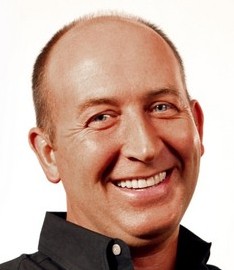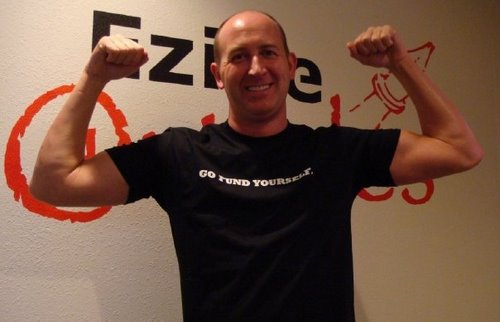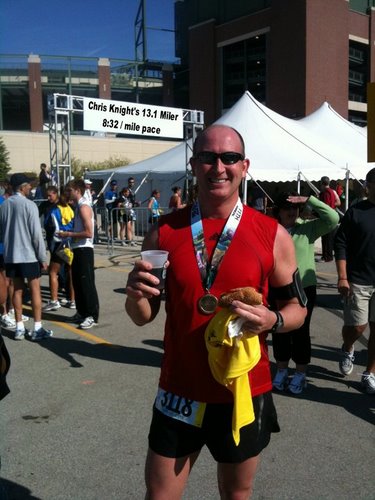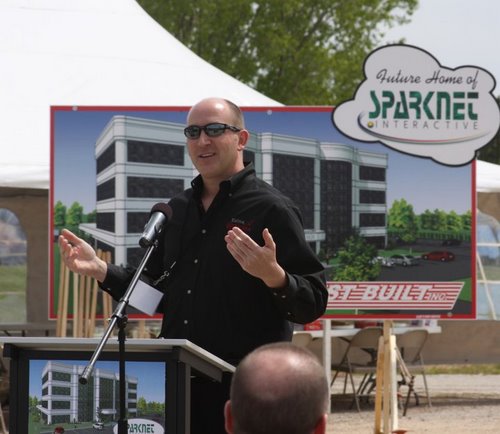- Learn How EzineArticles gets 30M uniques/month and delivers 200,000 clicks/day to its members
- Did You Know EzineArticles Has 80 Employees? Find Out What They Do
- Discover The Best Ways To Monetize Content – From Chris Knight At EzineArticles
Full Interview Audio and Transcript

Personal Info
Sports Teams: none (anyone except the bears!)
Favourite Books:
- Real Magic: Creating Miracles in Everyday Life by Wayne W. Dyer
- Delivering Happiness: A Path to Profits, Passion, and Purpose by Tony Hsieh
Favourite Entrepreneurs: Tony Robbins, Richard Branson, Sergey Brin and Larry Page, Michael Dell
Twitter: http://twitter.com/chrisknight
Personal Blog: http://christopher-knight.com
Company Website: http://ezinearticles.com
Interview Highlights
This is a condensed audio transcript. The full source audio is provided if needed. The interviewee may post corrections in the comments.
Adrian Bye: Today, I’m talking with Chris Knight, who runs EzineArticles. Chris is based near Chicago. Maybe you can come on and tell us a little bit about EzineArticles and what you have been doing
Chris Knight: Yeah, we are in the Midwest and we have a great college educated workforce and a great work ethic. The business began in November of 1999, and what we were doing back then is we were aggregating websites that were providing value to email newsletter publishers or Ezine publishers.
EzineArticles.com was originally designed to be a matching service between email newsletter publishers who need supplemental content that they can run it in their own newsletter free of charge and then experts in every walk of life, every business and non-business niche, and a person can come to our site and ethically, legally and for the license take up to 25 articles per site per year to use and run to their newsletter audience or to their website.
And the benefit, of course, for doing that is that the expert gets exposure to a likeminded niche market who might want that content. Everybody who has a website has the same problem. We all need traffic in order to make our Internet businesses work. So, that’s really the niche that we are trying to fill.
We are trying to deliver that high value traffic, but once someone has read your article and they have seen Adrian and what he can do and what his expertise is, well then when they visit your website, they are really warmed up to you, they already know something about you. Either they shared part of your skill with them and delivered value first.
Adrian Bye: So, you basically started off doing like general Internet marketing stuff, EzineArticles is one of multiple businesses you were running. You did that from 2001 through to about 2005. By then, contextual advertising had caught up and then you are like, “Well, maybe, we should put some more effort into this.” And then, did you basically read upon your other stuff and focus 100 percent on EzineArticles and sell or shut down the other businesses?
Chris Knight: Slowly, year by year, the other sites – some of them are still going. In fact, we integrated some of them into EzineArticles. For example, BestEzines.com is just an email newsletter directory, and we created PressExposure.com and that also is one of our sites that is a little known I guess, but if you send a press release to us, of course, we can’t accept it, but we will deflect it to PressExposure.com.
Adrian Bye: So, you had like a big active team of people reading every day?
Chris Knight: We have right now 80 people full time and we have plans for more.
Adrian Bye: You have 80 full time people who read everything that gets posted twice?
Chris Knight: Yes.
Adrian Bye: You are also paying a lot more than if you like; I mean, I’ll just say because it is going to sound funny, but why not have all that done in China?
Chris Knight: Good question. Here are 60 million people who can speak perfect English yet don’t have any of the cultural references to the bulk of the content coming in. The bulk of our content is English right now – and we are only English right now. And they speak perfect English, but yet they don’t have starting our life, they don’t have our pop culture. When we first make a joke, they don’t get the joke. That’s the same for India, same thing. It is not our culture, it is not their culture
Adrian Bye: So, you are just basically – you have gotten really good at SEO and like your good friends at Google and Yahoo as good as you can be basing a website, and that’s it. You get your traffic in, the people submit their articles and then you provide reporting and results to the people who submit articles, so they can see where the traffic is coming from.
Chris Knight: In fact, one of our goals was to – this is going back to 2005 now. In 2005, our Google delivered traffic was like 92 or 93 percent of our traffic and we thought, “You know what, this is really dangerous. We can’t do business like this.”
We created a plan. It was a multiyear plan and we said, “We’ve got to figure out a way to attract traffic in order to bring the total search engine delivered traffic to us to below 50 percent.” And here, our total search engine traffic delivered to us is below 50 percent, and we did that through RSS, we did it through email alerts. Like, right now, a person can come to our site, they can find you and they can subscribe to your alerts, which means, let’s say, you publish an article with us tomorrow, we will send an email tomorrow to anyone who is interested in seeing new articles by Adrian Bye.
So, we did a huge email-based ways to drive traffic. In addition, we also have, I think, a little over 10 million Twitter members that are following our members and we allow our members to automatically tweet from their account when they have new articles. And so that’s a significant exposure because that also then syndicates to FriendFeed and Facebook and different other sites that people syndicate from – LinkedIn, for example.
So, when a person tweets an article, then it goes back through that path and then it comes back to us, which then goes back to them. So, we put a lot of effort into getting traffic without the search engine. So, as much we still appreciate them and we do. It is only half the traffic.
And the biggest innovation that we have had is, we have created a system where we have full time people in our team that are title writers. And what we do is we comb through the tens of terabytes of data of referral logs that shows which keywords and key phrases are being used to find content. We correlate that with traffic and what we know from our history.
And then we have designed a system that helps accurately predict which article titles will pull the most traffic in the future, and we provide that through our article title suggestion tool for free for all members, and then they can come to the tool, they can put in a search word in their article title suggestion tool, and they can find out here is five or ten article titles that we believe if you write an article for will give you higher percentage of traffic than if you picked the title yourself.
What the headlines are based is, it is specifics basis backed by data, by extreme amount of data and then it is also human reviewed to make sure that, “Well, just because someone searching for this weird stuff, there is lot of search terms that wouldn’t make up an appropriate title,” which is why we have to then rewrite that data using the knowledge we have based on our traffic
And we have been doing this now for almost not quite a year and very soon we will be publishing what the actual differential is. And I think it is going to show significantly that we are going to try to prove that you shouldn’t make article titles up yourself.
You can do that, but eventually I will prove to you that we know better how to get you higher return on your time, so that if you know you just want to write about entrepreneurship or you want to write about skiing or you want to write about whatever your niche is, we want to give you the ability to search our titles and then find and write based on what the market is looking for, based on what they are currently searching for in volume.
Adrian Bye: I’m interested to know about your thoughts on contextual advertising and how well that works for you. And I mean, obviously, it is working pretty well. What kind of stuff you have tried, what’s worked and what hasn’t and all that sort of thing?
Chris Knight: We run a couple of hundred concurrent tests on a continuous basis and so our objective is how can we deliver not only the most targeted ads, but how can we deliver the fewest number of ads per article to get the maximum yield from that article without distracting from our members getting their maximum yield from the traffic. So, we monitor those 200,000 clicks going out the door everyday to our members and we want to continue to see that rise in proportion to the traffic.
But, we also wanted to see, when sometimes an article will get a huge ad clickthrough, but it will be a low member clickthrough, or the reverse happens where a member will get 30 percent clickthrough rate on a continuous basis and the ads won’t perform the same.
So, we look at not only the geotargeting of it all, but we’ve tested images, as well, and those failed in a lot of respects. We find that our members are very text oriented. Some things that people could test or they can see what we’re doing. We have a relationship with Google and others that allows us to test things that don’t work. Usually, we see them six months before the rest of the market sees, and those partnerships are important.
But, I’m not what sure. Are you looking for do this and you’ll improve your AdSense? Is that what you’re saying?
Adrian Bye: Yeah, you, obviously, know a lot about monetization of content. So, I’m interested to see basically what you’re running as Google AdSense, because that’s basically the gold standard.
Chris Knight: That is still the gold standard. I think that it’s the perfect alignment for what we’re doing today. However, if you had a niche site that only had one specific category of topics, then it might be a supplement. A lot of people think AdSense is supplemental advertising. It’s for when you have nothing else to fill and you run AdSense. And that makes good sense.
I think that if we didn’t have 700 different markets that we’re in, that AdSense wouldn’t be as great of a player with us that it is today. Because the real money, I think, in advertising are the display ads, the image ads, the video ads. The ads that are not text have a lot greater revenue per thousand impressions.
We don’t run a lot of those because, well, we’re largely text based and we’re speed obsessed. We want to deliver a fast user experience, and display ads don’t deliver that.
If I wanted to maximize my revenue yield though, and we were not a general site in all these different markets, we would deal with AdSense as much as we are
Adrian Bye: So, what you’re saying is that Google’s model is powerful because they have the most advertisers. And because they have the most advertisers, they’re going to be able to generate the overall highest cost per click. So, that means their overall model of what they’re doing with AdSense is extremely defensible.
Chris Knight: It is.
Adrian Bye: You’ve done a lot of testing. I’m looking at a page right now, “Why Choose an Old Town Kayak?” I’m seeing, I think, 16 ads on the page. Google will run between, what is it, 10 and up to maybe 13 ads on a search result. So, if you’re running 16 on one page, this is more than Google runs. Do you get higher revenues with more ads?
Chris Knight: Yes, generally more ads mean more revenue. But then, there’s also user experience.
Adrian Bye: Right.
Chris Knight: We determine and measure user experience by bounce rate and do they keep coming back? And then for us in our business, we have to make sure that is that member in that kayak article, are they still getting a two to twelve percent clickthrough rate? Are they still getting our site average or greater? And if they are, then 16 ads? OK.
Adrian Bye: The typical clickthrough rate is two percent. Is that clickthrough to the article source?
Chris Knight: Yeah, the average article receives a two to twelve percent average clickthrough rate. Like I think yours were at six percent, so you’re right smack in the middle. It’s everywhere in between there. Some get as high as 17 to 30 percent. Some get as low as one percent. If your clickthrough rate though is below one percent, then perhaps you’re not doing something right.
Adrian Bye: You’re saying at six percent I was average and that’s it?
Chris Knight: Yeah, well, you’re above average probably for some people. We have a lot of people at one to three percent.
Adrian Bye: So, what are the ones that are doing 12 percent or a 20 percent clickthrough?
Chris Knight: Some of those topics are anti-aging or weight loss, some of the mobile cell phone ones. Some of the categories are about sexuality. Again, we don’t have porn, but we have sexual education things. Dating has some of the higher CTRs.
So, it really depends on the niche that you’re writing in. The best article content in a niche that doesn’t have a traditionally high CTR, it doesn’t matter.
Adrian Bye: When you say CTR, what are they clicking on? Because on “Why Choose an Old Town Kayak?” I don’t see a link to that guy’s site. There’s “article source,” which goes to the EzineArticles link. Is there normally a link to their site as well somewhere?
Chris Knight: Every article has usually a self-serving link, at least one if not two. We usually recommend up to two. If it doesn’t have a self-serving link in there, you’re on a rare article.
Adrian Bye: I’m going to another one now. I’m on “How to Sharpen Your Boat Building Skills.”
Chris Knight: At one point, we had several hundred thousand dead links on our site. A year ago, we said, “You know what, it’s not a good user experience to deliver a user to a dead link.”
So, we built huge systems in the back end to help our members figure out if they have dead links and then giving them the chance to correct them. Over time, if they don’t correct them, eventually we unlink them, with proper notice to the member.
Adrian Bye: OK, so I’m seeing what they’ve done is put the keyword. So, at the end of this one, “for more information on small boat design, check out the info available online.” So, this is the URL. So, you’re then tracking clickthroughs to that link. So, you’re giving them the keyword text and then it’s clicked through to that link.
Chris Knight: Yes.
Adrian Bye: We’ve talked about a lot of stuff. Is there anything that you want to tell us about which we haven’t covered?
Chris Knight: Get started. It’s a free membership, right? Love to have everyone.
In fact, our positioning, if I can leave people with a thought, is that we want them as free members to our site to think of EzineArticles.com as what could become their largest non-search engine referrer of free traffic, and traffic that doesn’t just come when you buy it; meaning, comparing us to buying clicks, this is traffic that comes year after year after year, because we keep on getting people who say, “You know what? That article I wrote for you in 2005, it just netted me two hundred grand in landing me a speaking gig” or a consulting gig or a commercial or something that works with their business. So, it’s evergreen content that delivers traffic year after year after year after year.
So, it’s something that they should think of this as a long-term strategy. Do you advertise your business once or do you advertise your business every month, every quarter, every year? Well, when I look at writing and this whole article marketing concept that we do, it’s something you want to do on a continuous basis, not just once, because those who do it just once, really aren’t going to see the spoils from fully engaging the concept.
And then once you get the traffic coming, because you’ve submitted let’s say a 100 or 250 articles, it’s really difficult to stop that traffic. In fact, that’s the point where you start saying, “OK, let’s talk about your multiyear future so that you start thinking about how to rewrite your own URLs so that when you change your business, you continue to trap that lost traffic.”
Adrian Bye: Yeah, right.
Chris Knight: Because it happens. People are doing something different today than when they started with us, even if that’s two years ago. You don’t want to deliver your good name out in the market and then send them to a dead site because your business failed or because you changed what you’re doing. So, we want to help people to recapture that value.
Adrian Bye: Right. Cool. Well, Chris, thanks very much for doing the interview.
Chris Knight: I appreciate it. Thanks, Adrian.









